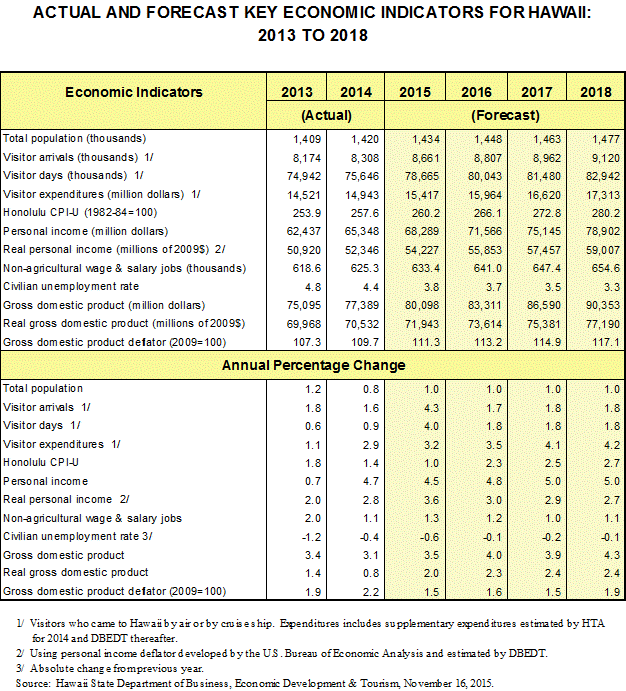Report: Hawai‘i Economy Will Continue Stable Growth
The Department of Business, Economic Development and Tourism released its fourth quarter “2015 Statistical and Economic Report,” which projects that the state’s economy will continue stable growth in the next few years.
Labor market conditions continued to improve through the first nine months of 2015, with civilian labor force, employment and payroll jobs setting historical high levels.
The report indicates a shift in the visitor market.
Reflecting the strong US dollar and weakening Japanese yen, Japanese arrivals declined by 1% through September and spending by Japanese visitors declined by 10.1%.
However, visitor arrivals from the US West market increased 7.5% and visitor expenditures from this market increased by 6.9%.
“We are pleased that Virgin America started a new daily flight from San Francisco to Honolulu on Nov. 2 and will start a new daily flight from San Francisco to Kahului on Dec. 3 this year,” said DBEDT Director Luis P. Salaveria. “This will bring more West Coast visitors to our state and offset the decline in Japanese visitors. This news and the continued growth in our local job market are positive trends in our state’s economy”
DBEDT keeps its visitor arrival projection unchanged for 2015 and slightly increased for 2016 to 2018 compared to the projection completed in August.
“From the passenger count data DBEDT collects on daily basis, passengers increased 4.1% for October and 4.8% for the first two weeks of November, explained Dr. Eugene Tian, economic research administrator.” “With an increase of 3.9% in scheduled air seats to Hawai‘i for the fourth quarter, we are confident that 2015 will be a record year for visitor arrivals.”
Due to the decrease in Japanese daily visitor spending, total visitor expenditures will be $15.4 billion, slightly lower than the $15.5 billion projected in the previous quarterly report.
Scheduled air seats will increase by 2.6% in the first quarter of 2016, indicating continued strong demand for travel. Visitor arrivals in the next few years will be stable in a 1.7 to 1.8% range.
Statewide, 8,100 non-agriculture payroll jobs were added during the first nine months of 2015 as compared with the same period in 2014. Retail trade added the most jobs at 1,700, healthcare and social services added 1,700 jobs, professional and business services added 1,600 jobs, food services and drinking venues added 1,500 jobs, and construction added 1,100 jobs. However, federal and state government lost 500 and 800 jobs, respectively, during the same time period.
Hawai‘i’s unemployment rate during the first nine months of 2015 was 3.9% and ranked the eighth lowest in the nation. Unemployment rates for all the counties in the state fell under 5% during the first nine months of 2015 and the gaps between Neighbor Island counties and Honolulu are getting smaller. During the first nine months of 2015, Honolulu’s unemployment rate was 3.6%, Hawai‘i County was 4.8%, Maui County was 4% and Kaua‘i County was 4.4%.
For the current economic projection, DBEDT projects that the non-agriculture payroll jobs will increase by 1.3% in 2015, higher than the projection of 1.1% projected in August. Payroll jobs will continue to increase at about 1.0 to 1.2% in the next few years.
DBEDT expects the unemployment rate will drop to 3.8% in 2015, lower than the 4% projected last quarter. The unemployment rate is expected to further drop to 3.3% in 2018.
The initial unemployment claims, another indicator for the labor market condition, declined 17.9% in 2015 as of the first week of November, from the same period in 2014. In a typical week during the 10 months of 2014, 1,642 people filed applications for unemployment benefits; that number dropped to 1,349 during the first 10 months of 2015.
Nominal (no inflation adjustment) personal income growth is projected to grow at 4.5% in 2015, higher than the 4.3% projection in August. According to the US Bureau of Economic Analysis, Hawai‘i personal income grew by 4.4% during the first half of 2015. DBEDT expects that personal income will increase more in the second half of the year.
With a lower inflation rate caused by the lower oil price, Hawai‘i consumers benefited from a stronger purchasing power from income. DBEDT estimated that real personal income will increase by 3.6% in 2015 and 3% in 2016. These real personal income growth rates are higher than those projected in the previous quarter.
DBEDT keeps its projection for the consumer inflation rate unchanged from the previous report—1% for 2015, then increasing to 2.3% in 2016 and 2.7% in 2018.
The construction industry continues to boom. The value of private building permits issued during the first nine months of 2015 increased by 28.7%, as compared with the same period a year ago. Leading the increase was the value of commercial and industrial construction permits with a 144% increase, followed by residential permits with a 79.7% increase. The value of permits for additions and alterations declined by 16.2% during the first nine months of 2015. The value of government contracts awarded also increased by 65.5% during the first three quarters of 2015. Construction jobs increased 3.5% during the first nine months of 2015, the second highest growth among all the industries (the highest payroll job growth was in arts, entertainment and recreation with 4.3% growth).
DBEDT revises the economic growth rate for 2015 to 2% from 1.9% projected last quarter and keeps the economic growth rate the same as projected in August at 2.3 to 2.4% until 2018. These economic growth rates are slightly lower than the US economic growth rates of 2.4% for 2015 and 2.6% for 2016.
Hawai‘i’s economic growth has been below the US since 2012 and DBEDT expects that the trend will continue for the next few years.
The “DBEDT Quarterly Statistical and Economic Report” contains more than 100 tables of the most recent quarterly data on Hawai‘i’s economy as well as narrative explanations of the trends in these data.











